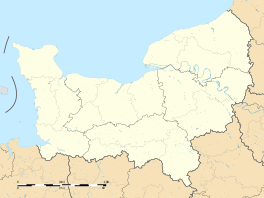Saint-Saëns, Seine-Maritime
| Saint-Saëns | ||
|---|---|---|
|
||
| Coordinates: 49°40′N 1°17′E / 49.67°N 1.28°ECoordinates: 49°40′N 1°17′E / 49.67°N 1.28°E | ||
| Country | France | |
| Region | Normandy | |
| Department | Seine-Maritime | |
| Arrondissement | Dieppe | |
| Canton | Neufchâtel-en-Bray | |
| Intercommunality | CC Bray-Eawy | |
| Government | ||
| • Mayor (2008–2014) | Jacky Hucher | |
| Area1 | 25.5 km2 (9.8 sq mi) | |
| Population (2006)2 | 2,568 | |
| • Density | 100/km2 (260/sq mi) | |
| Time zone | CET (UTC+1) | |
| • Summer (DST) | CEST (UTC+2) | |
| INSEE/Postal code | 76648 /76680 | |
| Elevation | 90–229 m (295–751 ft) (avg. 110 m or 360 ft) |
|
|
1 French Land Register data, which excludes lakes, ponds, glaciers > 1 km² (0.386 sq mi or 247 acres) and river estuaries. 2Population without double counting: residents of multiple communes (e.g., students and military personnel) only counted once. |
||
1 French Land Register data, which excludes lakes, ponds, glaciers > 1 km² (0.386 sq mi or 247 acres) and river estuaries.
Saint-Saëns ([sɛ̃ sɑ̃s], until about 1940-1950 [sɛ̃ sɑ̃]) is a commune in the Seine-Maritime department in the Normandy region in northern France. A small town of farming and associated light industry situated by the banks of the river Varenne in the Pays de Bray, some 19 miles (31 km) southeast of Dieppe at the junction of the D929, D12, D99 and the D154 roads. Junction 11 of the A28 autoroute with the A29 autoroute is within the commune’s territory.
The year 674 saw the foundation of a monastery on the hill at the present-day location of the village. The first abbot was Sidonius (Saëns), an Irish monk and a disciple of St Philibert of Jumièges. Sidonius died in about 689 and was buried in the monastery.
Called "Sancti Sidonii" in a document of around 830, it was destroyed by the Vikings in the 9th century. In the 11th century, the seigneurs of Saint-Saëns were rich and powerful men. One of them became governor of Rouen and another excelled at the Battle of Hastings. In 1127, Helias of Saint-Saens was outlawed in England on the orders of Henry I of England for sheltering Guillaume Cliton, rebel claimant to the duchy of Normandy. The seigneurs built again on Cateliers hill, this time a castle and a collegiate church which later became the Benedictine abbey of Saint-Wandrille.
...
Wikipedia



